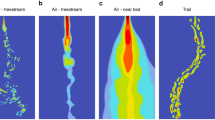Summary
Manduca sexta escapes from the pupal cuticle by coordinated movements of abdomen, wing-bases, and legs. We have examined the thoracic motor output during eclosion by recording extracellularly from the indirect flight muscles. The motor pattern produced during wing-shrugging movements (Fig. 2) is characterized by alternating activity in the flight muscles and increasing numbers of muscle potentials per burst in successive cycles of wing movements. The wing-shrugging motor pattern differs from that of flight and from the pattern produced by an adult moth with its wings restrained (Figs. 3, 6). Eclosion behavior, including the typical motor pattern, can be induced prematurely, 30–36 h before eclosion. Young adults that have already expanded their wings can be stimulated to repeat the eclosion and wing-expansion behavior, but after 20 h post-eclosion, both responses disappear (Fig. 5). Restraint and mechanical stimulation, particularly of the legs, are important stimuli in eliciting eclosion behavior. Since eclosion in saturniid moths is initiated by a hormone, the effectiveness of mechanical stimuli was unexpected.
Similar content being viewed by others
References
Altman, J.S.: Changes in the flight motor pattern during the development of the Australian plague locust,Chortoicetes terminifera. J. comp. Physiol.97, 127–142 (1975)
Bastock, M., Blest, A.D.: An analysis of behaviour sequences inAutomeris aurantica Weym. (Lepidoptera). Behaviour12, 242–284 (1958)
Blest, A.D.: The evolution, ontogeny and quantitative control of the settling movements of some new world saturniid moths, with some comments on distance communication by honeybees. Behaviour36, 188–253 (1960)
Casaday, G.B.: Neurodevelopment in a thoracic ganglion of a moth: identified motor neuron and microanatomical structure. Thesis, Cornell University (1975)
Fraenkel, G., Hsiao, C.: Bursicon, a hormone which mediates tanning of the cuticle in the adult fly and other insects, J. Insect Physiol.11, 513–556 (1965)
Heinrich, B., Bartholomew, G.A.: An analysis of pre-flight warm-up in the sphinx moth,Manduca sexta. J. exp. Biol.55, 223–239 (1971)
Kammer, A.E.: A comparative study of motor patterns during pre-flight warm-up in hawkmoths. Z. vergl. Physiol.70, 45–56 (1970)
Kammer, A.E., Rheuben, M.B.: Adult motor patterns produced by moth pupae during development. J. exp. Biol.65, 65–84 (1976)
Kutsch, W.: The development of the flight pattern in the desert locust,Schistocerca gregaria. Z. vergl. Physiol.74, 156–168 (1971)
Kutsch, W.: The influence of the wing sense organs on the flight motor pattern in maturing adult locusts. J. comp. Physiol.88, 413–424 (1974)
Lockshin, R.A.: Degeneration of insect intersegmental muscles: electrophysiological studies of populations of fibres. J. Insect Physiol.19, 2359–2372 (1973)
Lockshin, R.A., Williams, C.M.: Programmed cell death. I. Cytology of degeneration in the intersegmental muscles of the Pernyi silkmoth. J. Insect Physiol.11, 123–133 (1965)
Lockshin, R.A., Rosett, M., Srokose, K.: Control of ecdysis by heat inManduca sexta. J. Insect Physiol.21, 1799–1802 (1975)
Petersen, B., Lundgren, L., Wilson, L.: The development of flight capacity in a butterfly. Behaviour10, 324–339 (1957)
Provine, R.R.: Eclosion and hatching in cockroach first instar larvae: a stereotyped pattern of behaviour. J. Insect Physiol.22, 127–131 (1976)
Rheuben, M.B.: The resting potential of moth muscle fibre. J. Physiol. (Lond.)225, 529–554 (1972)
Srivastava, B.B.L., Hopkins, T.L.: Bursicon release and activity in haemolymph during metamorphosis of the cockroach,Leucophaea maderae. J. Insect Physiol.21, 1985–1993 (1975)
Taylor, M., Truman, J.W.: Metamorphosis of the abdominal ganglia of the tobacco hornworm,Manduca sexta. J. comp. Physiol.90, 367–388 (1974)
Truman, J.W.: Physiology of insect ecdysis. I. The eclosion behaviour of saturniid moths and its hormonal release. J. exp. Biol.54, 804–814 (1971)
Truman, J.W.: Physiology of insect ecdysis. II. The assay and occurrence of the eclosion hormone in the Chinese oak silkmoth,Antheraea pernyi. Biol. Bull.144, 200–211 (1973a)
Truman, J.W.: Physiology of insect ecdysis. III. Relationship between the hormonal control of eclosion and of tanning in the tobacco hornworm,Manduca sexta. J. exp. Biol.58, 821–829 (1973b)
Truman, J.W.: Development and hormonal release of adult behavior patterns in silkmoths. J. comp. Physiol.107, 39–48 (1976)
Truman, J.W., Endo, P.T.: Physiology of insect ecdysis: neural and hormonal factors involved in wing-spreading behaviour of moths. J. exp. Biol.61, 47–55 (1974)
Truman, J.W., Reiss, S.E.: Dendritic reorganization of an identified motor neuron during metamorphosis of the tobacco hornworm moth. Science192, 477–479 (1976)
Truman, J.W., Riddiford, L.M.: Neuroendocrine control of ecdysis in silkmoths. Science167, 1624–1626 (1970)
Yamamoto, R.T.: Mass rearing of the tobacco hornworm. II. Larval rearing and pupation. J. econ. Ent.62, 1427–1431 (1969)
Author information
Authors and Affiliations
Additional information
This work was supported by NSF grant No. BNS75-18569. We are grateful to Dr. Karl Kramer and his associates at the U.S. Grain Marketing Research Center for providing animals. We thank Dr. Kramer and Dr. John Kinnamon for a critical reading of the manuscript. We also thank Dr. James Truman for sending us a copy of his recent paper prior to its publication.
Rights and permissions
About this article
Cite this article
Kammer, A.E., Kinnamon, S.C. Patterned muscle activity during eclosion in the hawkmothManduca sexta . J. Comp. Physiol. 114, 313–326 (1977). https://doi.org/10.1007/BF00657326
Received:
Issue Date:
DOI: https://doi.org/10.1007/BF00657326




